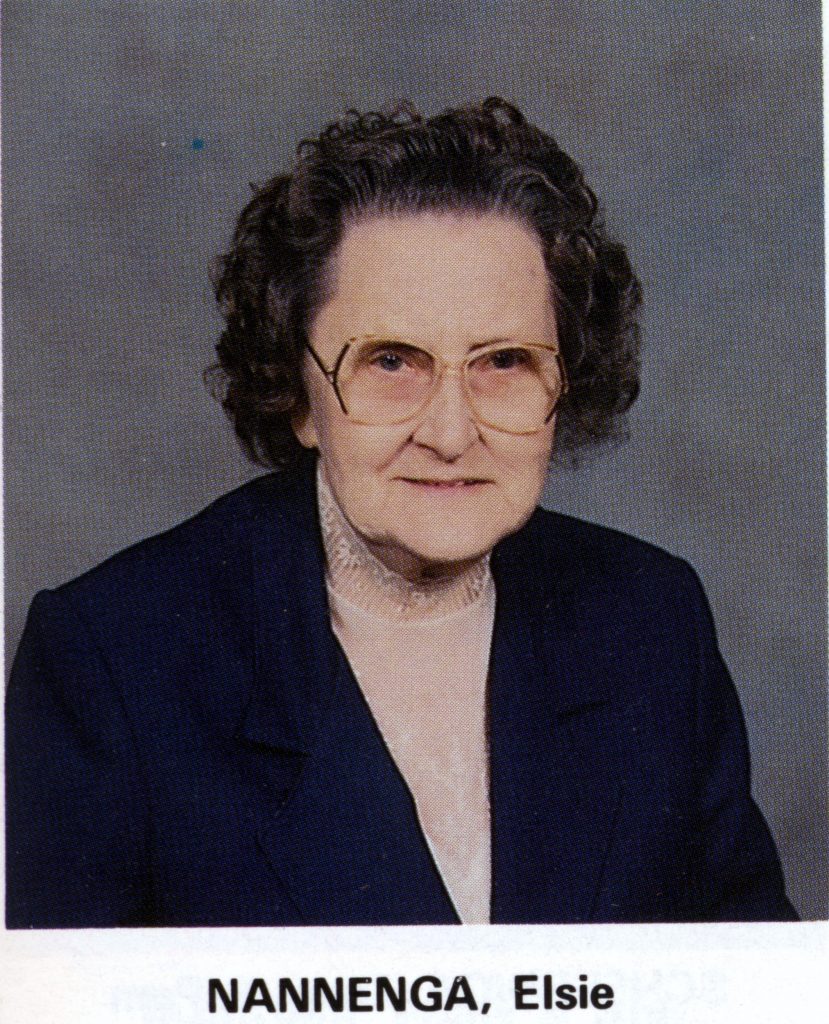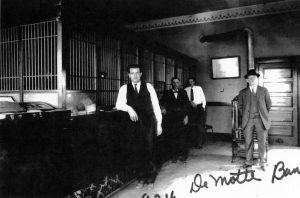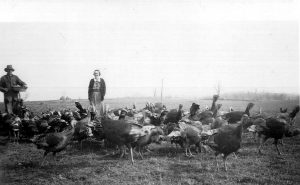Elsie Nannenga
THE SETTLING OF THE GRAND MARSH OF THE KANKAKEE
RIVER
Interviewed by Laverne Terpstra, Transcribed by Flo Riley
August 1, 1995
I was born January 29, 1913 on the Otis Ranch farm three miles south of DeMotte.
My parents came with their parents from Holland. Mother at the age of eleven and father about twenty-one years old. They met in Chicago. Father’s parents moved to a DeMotte farm after a couple of years and my parents moved to DeMotte when the Pullman strike, where my father had been working, made it impossible to find work in Chicago. My parents moved to large farm rented from the Otis Estate. That farm was my birth place.
Three brothers and three sisters helped my parents run the farm, all work was done with horses. Father raised horses, cows and pigs. The upper part of a large horse barn was filled with hay with a silo next to the cow barn and held ensilage for the cows. Most of the food for the animals was grown on the farm. Sisters and mother as well as brothers and father all milked the cows morning and evening. I was spared this job because of my age, however, riding horseback to bring the cows from the pasture was part of my chores as well as keeping cobs and sticks for starting the morning fires. Our chicken were kept fenced in so egg gathering, also part of my chores, was simple.
Threshing, silo filling and buzzing wood were big events in a farmer’s life and the farmer’s wife got to feed a lot of men at that time. When buzzing wood the men would go out to the woods, cut trees, haul them home and pile them up. Then the buzz saw would come, a group would come and the wood would be cut into blocks. In the winter, when there wasn’t too much work, the boys would chop them up and pile them up so that we had wood all year round.
We had a large garden, fruit trees and grapes which added to our diet. A root cellar was filled each fall and jars of canned fruit was shelved in extra closets. Some meat, butchered at home, was salted and put in crocks. The hams and bacon were smoked in a smoke house that was near our home. Branches from apple trees were used because that was supposed to make the meat taste better. Some meat was canned, also. We were warned it was dangerous, but mother canned her meat in the oven.
About the time I was eleven years of age my brothers and sisters had found jobs away from home or married, so my dad retired to a small farm nearer DeMotte. I spent twelve years in the DeMotte School, the only one in my family to graduate. After high school I spent a year in South Bend Business College which educated me enough to get a bookkeeping position in the DeMotte Bank. I was the first female to hold that position. Up until then men, supposedly more capable, held that position.
As a little girl, Santa Claus always brought me a present on Christmas, but the day was usually spent in church for Christian Fellowship.
On Sundays, we had Young People’s Society in our church. On one particular Sunday I was leading and when I looked up Simon, who was to become my husband, was sitting in the back seat. He went to the American Reformed Church, not to our First Church. The discussion was on when Jesus spoke and said, “Simon, lovest thou Me”. I looked up and sure enough Simon loved me, he was in the back seat shaking his head, “Yes, Yes”. After a five-year courtship we were married and were the parents of four beautiful daughters. We have thirteen grandchildren and ten great-grandchildren spread over the United States.
Si and I made our living dressing chickens and taking them into the city. This was a far cry from what my father did. He raised turkeys on the farm. A week or so before Thanksgiving ‘dressing day’ was arranged and everybody went into the barn. The turkeys were killed, hung up and dressed dry. When we had turkeys and chickens to dress, we dipped them in hot water. My husband made what we called a “chicken picker”. It had a tank that went round and round electrically. There were rubber fingers through it which would remove the feathers. The birds were secured by the legs on a dipper and were dipped in and out of hot water for a certain period of time. Then they were put over the rubber fingers. The chicken came out clean and not bruised or torn if we were careful.
My daughters and I would stand in a row, grab those birds, chop their heads off and send them on down where they were butchered and thrown into ice water for a day. Then we took them into the city. Each bird was ordered in advance and so each person got their turkey. It was an exciting, busy weekend and by Thanksgiving we were tired but delighted that we were finished.
We would start dressing turkeys around four o’clock in the morning. Si would be up early and have the water hot and my daughters and I would go out and the six of us would start in. Lots of times we hired someone to help us out. We generally dressed about one hundred, put them in ice water and that night we still had to pack them into the truck. We put oilcloth on the floor of the truck and packed our turkeys with ice around them. We had holes bored into the truck body so that the water, which came from the melting ice, could drain out. We didn’t want any water on the turkeys. Chickens were small enough that we would pack them in specially made ice boxes. Simon made arrangements with Harry Van Wienen to put the lining in for us and made one hole to drain the chickens.
We gathered eggs from southern Indiana, brought them here and we candled them, taking out those with specks or bad places. They were placed in little one dozen boxes and delivered from door to door three days a week. This was our weekly money that we made. Turkeys and the extra chickens on Thanksgiving and Christmas, that was when we had our harvest.
This concludes the interview with Elsie Nannenga.




